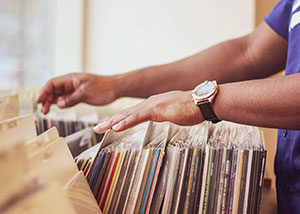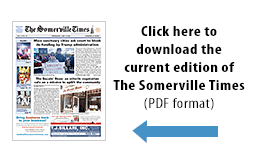
The Somerville Rock + Roll Yard Sale returned to Somerville on Sunday in Union Square Plaza, offering stacks of used records and live entertainment.
By Ryan DiLello
Johnny Cash’s rendition of Sunday Morning Coming Down played in my headphones as I walked down Prospect Hill to Somerville’s annual Rock + Roll Yard Sale in Union Square last Sunday.
It was two in the afternoon and the sun was baking the pavement in the plaza. People were moving slowly, partly to view the records, partly because of the heat. While Cash sang about reaching for a beer in the morning, I could see the vinyl junkies floating bin to bin, looking for their next analog fix.
The market consisted of a small conglomeration of tents, most of which housed enormous amounts of used records. Small laminated labels popped out of the vinyl like drowning sailors, declaring genres and band names of yesteryear. A few tents boasted reprints of iconic graphic tees, which hung motionless, dead in the wind. If there was any conversation to be heard, it was overwhelmed by the thwap, thwap, thwap sound of people flipping through records.
Local Boston rock group The Marshalls were wrapping up the first leg of their set and a few onlookers cheered. I thought their sound resembled an early Jefferson Airplane. Contrary to what their Marshall name might suggest, there were no full-stack amplifiers nor deafening guitar tones to be heard. Apt for today’s live music venues, the group’s guitar players were flanked by two 10-watt Fender Princetons – each turned to moderate volumes.
“Cause there’s something, in a Sunday / Makes your body feel alone,” Cash muttered through my headphones, his voice sounding like rocks grinding on pavement. I stepped further into the market, eager to find my next companion of an album.
The tents were tightly packed – people, records, and all. As I explored my first crate of the day, I tucked my elbow to preserve access to the bin next to me, which a man was furiously thumbing through. “Suppose that’s how the veterans do it,” I thought, as I caught the plastic of one record and clumsily recruited my other hand to hold back the growing mass of records I’d moved past.
I appreciated the friendly prices, especially the discounted wildcard bins. I thought of Steven Kotler, owner of Round Again Records in Providence, peering over at me from behind the checkout. “These aren’t pre-Columbian artifacts,” he would mutter, gesturing around his hole-in-the-wall shop – a favorite of mine back home.
Artifacts or not, the smell of mothballs, tobacco, and aged paper filled the air. We were all trekking down nostalgia road, kicking up clouds of our grandparents’ ashes, perfume, and dead skin. And as I walked along a sea of records, I reflected on how music listening has changed.
The era of “1000 songs in your pocket” certainly has its upsides in terms of breadth and accessibility, but does it offer comparable fulfillment for the ear and mind?
Records are the most comprehensive form of music as a thing, if not as a commodity. I believe they do the most justice to this vague notion of a “recording,” which always begs the questions, a recording of what? At what time? By whom? How? In what form? To what end?
The very best records address all of these questions and then some. In a thoughtfully crafted package, albums combine liner notes from the artist and/or producer with candid images of the creative process; they feature tangible artwork, and the vinyl itself contains the grooves to be electro-magnetically amplified in a way, analogous to electric guitar. One could argue, records are an automated instrument. On top of all of this, records combat the kind of musical ADHD that so many of us succumb to at the helm of today’s streaming platforms. With their continuous, unilateral playstyle, the listener is disarmed from the skip button. Records enable you to listen to music the way an artist intended.
In a word, records are a presentation. A presentation in that records comprise multiple forms of media to best capture a musical creation, bearing in mind all the ineffable ways in which it affects us. The italics nod toward the way in which records demand the listener remain in the present – mechanically (by setting up and tending to the record), auditorily (via the vivacity of analog sound), and temporally (in the “real-time” playback of a record).
Rock may be dead, but as records keep rolling, one must wonder whether the next musical revolution will be waged on the grounds of the medium, rather than the content.















What a load of BS, Rock and Roll is alive and kicking, it’s not dead! I go to Rock shows frequently. YOU, are a liar!
Have to agree with John. What a bizarre “news article”.
“As I explored my first crate of the day, I tucked my elbow to preserve access to the bin next to me, which a man was furiously thumbing through. ‘Suppose that’s how the veterans do it’….”
Furiously thumbing through? Veteran? More like a flipper.